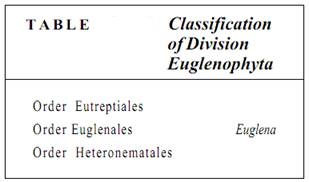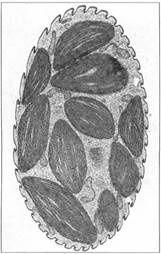
Division Euglenophyta: Euglenoids
 المؤلف:
AN INTRODUCTION TO PLANT BIOLOGY-1998
المؤلف:
AN INTRODUCTION TO PLANT BIOLOGY-1998
 المصدر:
JAMES D. MAUSETH
المصدر:
JAMES D. MAUSETH
 الجزء والصفحة:
الجزء والصفحة:
 19-11-2016
19-11-2016
 1778
1778
Division Euglenophyta: Euglenoids
This division comprises a rather large group of organisms: More than 800 species have been discovered, named, and placed into 36 genera (Table). Its members, euglenoids, illustrate the problem of trying to classify protistans as plants or animals: 25 genera never have chloroplasts at all, but 11 do. Most are unicellular (Fig. 1), but in some species a few cells remain together after cell division.
The green euglenoids are capable of photosynthesis, having chlorophylls a and b, but carbohydrate is stored as the glucose polymer paramylon, not as starch. Euglenoid chloroplasts are extremely sensitive to antibiotics that interfere with 70S ribosomes, and exposure to streptomycin results in the loss of chloroplasts and colorless "bleached" individuals.


FIGURE 1: The pellicle, now often called a periplast, is not a cell wall, but rather a thick layer of elastic proteins that accumulate just below the plasma membrane (X 11,700).
Many colorless individuals, both natural and bleached, take in food particles by phagocytosis (engulfing their food), and most can absorb sugars and even proteins through their plasma membrane. Even chlorophyllous species grow faster in light if supplied with organic compounds, and all must obtain B vitamins from the environment.
Euglenoids swim actively with two flagella located at the cell's anterior end, one short and the other quite long. An important nonplant character in euglenoids is lack of a cellulose wall; instead their surface contains a layer of elastic proteins called a pellicle (also called a periplast), which is located under the plasma membrane and gives the cell some rigidity and shape, but it is very different from a typical plant wall.
A representative example is Euglena ; individuals are elongate cells that, owing to their pellicle, have a somewhat ovoid shape, although they flex as they swim. At the anterior end is an invagination, the canal. The two flagella are attached at the base of the canal and then extend upward, but only one is long enough to emerge from the canal and be useful for swimming. At the side of the canal, near the base of the flagella, is an eyespot composed of many small, orange droplets of carotenoids. There are numerous disk-shaped chloroplasts, each containing a region called a pyrenoid; in most algae the pyrenoid is involved in polymerizing sugars into reserve polymers. That may also be true in Euglena, but the reserve paramylon accumulates outside the chloroplast, away from the pyrenoid.
Certain features are consistent with the hypothesis that euglenoids are relictual eukaryotes. During mitosis the nuclear envelope and nucleolus persist, and spindle microtubules form within the nucleus. Chromosomes are aligned lengthwise on the spindle, not crosswise as in other eukaryotes, and each chromatid appears to have its own minispindle consisting of four centromere microtubules and 8 to 12 longer microtubules. Cell division is by longitudinal cleavage, not by phragmoplast and cell plate, and after division chromosomes remain condensed. Neither meiosis nor sexual reproduction has been found in any euglenoid. All this could be interpreted as representing an early stage in the evolution of a true nucleus and mitosis, normal mitosis and meiosis apparently having not arisen until after the origin of euglenoids.
 الاكثر قراءة في الطحالب
الاكثر قراءة في الطحالب
 اخر الاخبار
اخر الاخبار
اخبار العتبة العباسية المقدسة


